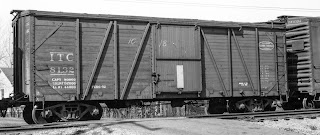In my recent post on the Kadee early version of the 40' PS-1 box car decorated for New Haven, I noted the new Universal 5700XL power hand brake with M2049 hand wheel (and NOT the significantly more common M1704 hand wheel) on the model. Although it is incorrect for this particular New Haven PS-1 (or any New Haven car to my knowledge) it does have several applications. Here is a list of prototypes I have assembled (with photos in some instances) that I am sure is by no means exhaustive:
- CNW Emergency box car (photo below)
- CNW Modified 1937 AAR box car
CNW Emergency box car at left. Note top operated coupler
EJ&E Modified 1937 AAR box car at right. Note Barber S-1 trucks and Wine ladders
- DICX 218 dry ice car (Mainline Modeler, March 1986)
- EJ&E Modified 1937 AAR box car (photo above)
- IHB 1937 AAR box car Lot 729-B
- IHB Modified 1937 AAR box car Lot 730-B
- MDT 500-series/8000-series refrigerator cars (Mainline Modeler, March 1986)
- NRC 17000-series refrigerator cars (Mainline Modeler, March 1986)
- NYC 50' AAR box car with end door Lot 693-B
- NYC 10'0" inside height Postwar AAR box car Lot 737-B (many reassigned to Pacemaker service, photo below)
At left, the old way to simulate this style of Universal hand wheel, using a Detail Associates Ureco part, on a kitbashed model of an NYC Lot 693-B end door box car
Right, a postwar 10'0" inside height AAR box car from Lot 737-B transitioned to Pacemaker service
- P&LE 50' AAR box car Lot 698-B
- PRR X38A automobile car (photo below)
- PRR X38B Emergency box car
- SP and T&NO B-50-25 10'0" inside height 12-panel box car (car nos. SP 21500-21749; T&NO 54850-55199)
At left, a PRR X38A automobile car with Universal power hand brake and, at right, a closeup of the same hand brake on the lone X38B Emergency box car (note M2049 cast into the wheel at roughly 5 o'clock)
- UP HK-50-5 Emergency ballast hopper (photo below)
- some of the UP (and sister line) B-50-24 and -27 alternate center rivet (ACR) lightweight box cars may have used this version of the Universal hand wheel. Photos needed for verification
Union Pacific HK-50-5 Emergency ballast hopper





















































